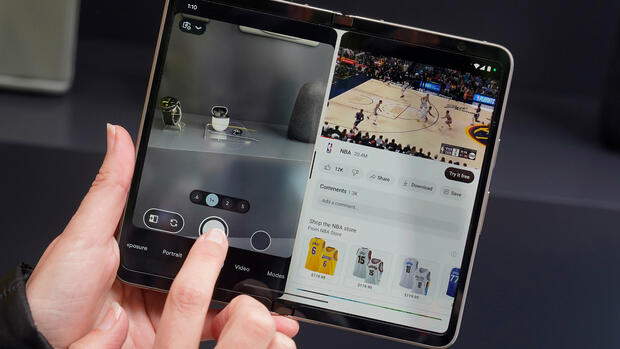The tech group is now also bringing out a foldable smartphone.
(Photo: AP)
new York Google has introduced its first foldable smartphone. With the Pixel Fold, which the tech group presented at its I/O developer conference on Wednesday evening, the Mountain View group is targeting the competition from Samsung.
With other hardware innovations, Google is pushing past its tech competitor Apple. AI applications are built into almost all products.
The Pixel Fold has a 7.6-inch screen and folds to the size of a (slightly thick) smartphone. What is particularly popular with those who have already held the device in their hands: In contrast to the Samsung Galaxy Z Fold 4, the two halves of the screen fold together practically seamlessly. A small gap remains on the hinge of the Korean competitor’s device.
The Pixel Fold has five cameras: three on the back, a 9.5-megapixel “selfie” camera on the back screen and an eight-megapixel camera on the main screen for video conferencing.
This arrangement of the cameras allows a further field of application: The Pixel Fold can be used as a live interpreter without the participants having to sit next to each other, hardware boss Rick Osterloh announced at the presentation.
Users then see what the other person is saying on their screens in almost real time and in their own language. People sitting opposite each other can use the same device for this, in video conferences it runs over several. Osterloh promises that this will make the conversation more natural.
However, this function was not initially available. It is to be rolled out via an update of the Android 14 operating system in autumn.
The foldable device is a bit thicker than current smartphones.
(Photo: Google)
The Handelsblatt was able to try out one of the new folding phones at the Google presentation in Mountain View. Switching between the different views worked without any problems. However, the display was sometimes difficult to read in the blazing Californian sun.
Control center for smart home applications
The new functions come at a price. The Pixel Fold initially costs 1899 euros in Germany. Google is orienting itself on the Samsung Galaxy Z Fold 4. Observers justify the high price with the large screens of the device – usually the most expensive hardware component.
With the Google offer, Apple is practically the last leading smartphone manufacturer without a clamshell phone in the range. Osterloh announced that Fold buyers will receive a Pixel Watch wristwatch free of charge until the beginning of July.
In addition to the clamshell phone, Google has introduced a new Pixel tablet. It costs 679 euros (with 128 GB memory) or 799 euros (with 256 GB memory). It has an eleven-inch screen and is optimized for running multiple apps at the same time.
Google’s new tablet can be set up for multiple users.
(Photo: Google)
A charging station including speakers is included in the price. The tablet sticks to it magnetically. In a first test by the Handelsblatt, switching between music playback on the tablet and the loudspeaker worked without any problems.
The ability to set up multiple users for the tablet was also positive. This makes it possible for several family members or colleagues to share a tablet. This feature has so far been missing from Apple’s iPad series.
Google emphasizes the tablet’s software and powerful processor. The group wants to position it as a control center for smart home applications, such as intelligent lighting, thermostats or video doorbells. It would be combined with the already introduced Google Home app.
Entry-level smartphone and tracking function
While the Pixel Fold covers the high-end market, Google is targeting more price-conscious buyers with the Pixel 7a smartphone, the “little brother” of the Pixel 7 Pro. It is available in Germany for 509 euros.
The smartphone has practical Google functions that Apple’s much more expensive iPhones lack.
(Photo: AP)
According to Google, the Pixel 7a has a powerful processor that should also make AI functions possible, including the Pixel call assistant, which can pre-filter callers and block out background noise in calls. The device also has some practical Google functions that Apple’s much more expensive iPhones lack – including the ability to have received voice messages transcribed.
At its house conference, Google also announced that it would expand the tracking function, which users can use to find lost devices and at the same time counteract surveillance. Google’s own “Find My Device” network should be improved for this.
In the future, Google smartphones could recognize unknown Bluetooth devices in luggage. Users should then receive warnings about unknown trackers traveling with them.
The announcement follows Apple and Google’s move to launch an industry-wide initiative to warn users of unwanted tracking from Bluetooth devices. The feature is expected to roll out later this summer and will also work with Apple’s Air tag trackers. In addition, the Bluetooth trackers from Tile, Chipolo and Pebblebee should be supported.
More: AI: Google wants to make up for Microsoft’s lead
